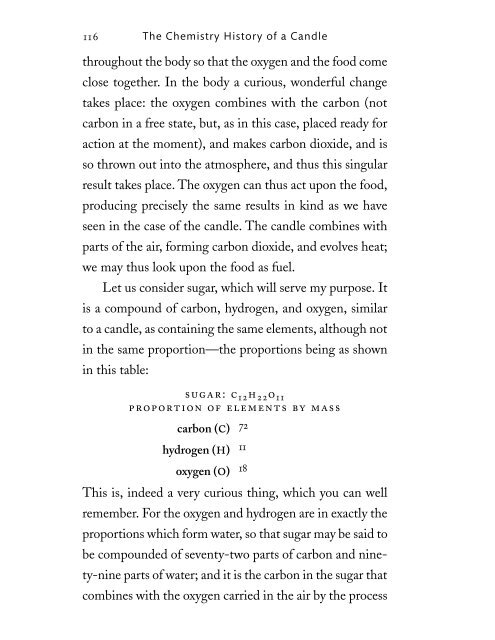Michael Faraday's The Chemical History of a Candle
Michael Faraday's The Chemical History of a Candle With Guides to Lectures, Teaching Guides & Student Activities by Bill Hammack & Dos DeCoste
Michael Faraday's The Chemical History of a Candle With Guides to Lectures, Teaching Guides & Student Activities by Bill Hammack & Dos DeCoste
Create successful ePaper yourself
Turn your PDF publications into a flip-book with our unique Google optimized e-Paper software.
116 <strong>The</strong> Chemistry <strong>History</strong> <strong>of</strong> a <strong>Candle</strong><br />
throughout the body so that the oxygen and the food come<br />
close together. In the body a curious, wonderful change<br />
takes place: the oxygen combines with the carbon (not<br />
carbon in a free state, but, as in this case, placed ready for<br />
action at the moment), and makes carbon dioxide, and is<br />
so thrown out into the atmosphere, and thus this singular<br />
result takes place. <strong>The</strong> oxygen can thus act upon the food,<br />
producing precisely the same results in kind as we have<br />
seen in the case <strong>of</strong> the candle. <strong>The</strong> candle combines with<br />
parts <strong>of</strong> the air, forming carbon dioxide, and evolves heat;<br />
we may thus look upon the food as fuel.<br />
Let us consider sugar, which will serve my purpose. It<br />
is a compound <strong>of</strong> carbon, hydrogen, and oxygen, similar<br />
to a candle, as containing the same elements, although not<br />
in the same proportion—the proportions being as shown<br />
in this table:<br />
Sugar: C 12 H 22 O 11<br />
Proportion <strong>of</strong> Elements by Mass<br />
carbon (C) 72<br />
hydrogen (H) 11<br />
oxygen (O) 18<br />
This is, indeed a very curious thing, which you can well<br />
remember. For the oxygen and hydrogen are in exactly the<br />
proportions which form water, so that sugar may be said to<br />
be compounded <strong>of</strong> seventy-two parts <strong>of</strong> carbon and ninety-nine<br />
parts <strong>of</strong> water; and it is the carbon in the sugar that<br />
combines with the oxygen carried in the air by the process


